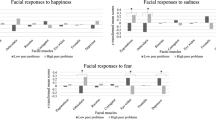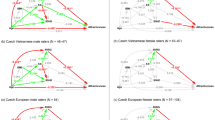Abstract
The present study investigated the relationship between ratings of attractiveness based on facial and those based on full-length photographs and how these ratings are related to peer interaction in preschoolers. Aggressive and prosocial peer interactions were observed in 38 preschool-age children. Attractive girls received more prosocial and fewer aggressive advances than unattractive girls. There was no differential treatment of boys related to attractiveness. Results were discussed in relationship to possible developmental implications and their parallel to the adult literature.
Similar content being viewed by others
References
Abramovich, R., Corter, C., & Lando, B. Sibling interaction in the home. Child Development, 1979, 50, 997–1003.
Anastasi, A. Psychological testing, 3rd ed. New York: Macmillan, 1968.
Bar-Tal, D., & Saxe, L. Effect of physical attractiveness on the perception of couples. Proceedings of the Division of Personality and Social Psychology, 1974, 1, 30–32.
Bar-Tal, D., & Saxe, L. Physical attractiveness and its relationship to sex role stereotyping. Sex Roles: A Journal of Research, 1976, 2, 123–133.
Byrne, D., London, G., & Reeves, K. The effects of physical attractiveness, sex, and attitude similarity on interpersonal attraction. Journal of Personality, 1968, 36, 259–271.
Dion, K. K. Young children's stereotyping of facial attractiveness. Developmental Psychology, 1973, 9, 183–188.
Dion, K. K., & Berscheid, E. Physical attractiveness and peer perception among children. Sociometry, 1974, 37, 1–12.
Dion, K. K., & Stein, S. Physical attractiveness and interpersonal influence. Journal of Experimental and Social Psychology, 1978, 14, 97–108.
Dion, K. K., Berscheid, E., & Walster, E. What is beautiful is good. Journal of Personality and Social Psychology, 1972, 24, 285–290.
Hildebrandt, K. A. The role of physical appearance in early development. In H. E. Fitzgerald, B. Lester, & M. Yogman (Eds.), Theory and research in behavioral pediatrics, Vol. 1. New York: Plenum Press, 1982.
Iwawaki, S., Lerner, R. M., & Chihara, T. Development of personal space schemata among Japanese in late childhood. Psychologia: An International Journal of Psychology in the Orient, 1977, 20, 89–97.
Krebs, D., & Adinolfi, A. A. Physical attractiveness, social relations, and personality style. Journal of Personality and Social Psychology, 1975, 31, 245–253.
Langlois, J. H., & Downs, A. C. Peer relations as a function of physical attractiveness: The eye of the beholder or behavioral reality? Child Development, 1979, 50, 409–418.
Langlois, J. H., & Stephan, C. Effects of physical attractiveness and ethnicity on children's behavioral attributions and peer preferences. Child Development, 1977, 48, 1694–1698.
Langlois, J. H., & Styczynski, L. E. The effects of physical attractiveness on the behavioral attributions and peer preferences of acquainted children. International Journal of Behavioral Development, 1979, 2, 325–341.
Lerner, R. M. The development of personal space schemata toward body build. Journal of Psychology, 1973, 84, 229–235.
Lerner, R. M., Karabenick, S. A., & Meisels, M. Effects of age and sex on the development of personal space schemata toward body build. Journal of Genetic Psychology, 1975, 127, 91–101.
Miller, A. G. Role of physical attractiveness in impression formation. Psychonomic Science, 1979, 19, 241–243.
Miller, A. G., Gillen, B., Schenker, C., & Radlove, S. The prediction and perception of obedience to authority. Journal of Personality, 1974, 42, 23–42.
Smits, G. J., & Cherkoniah, I. M. Physical attractiveness and friendliness in interpersonal attraction. Psychological Reports, 1976, 39, 171–174.
Styczynski, L. E., & Langlois, J. H. The effects of familiarity on behavioral stereotypes associated with physical attractiveness in young children. Child Development, 1977, 48, 1137–1141.
Tranavsky, P. A., & Bakeman, R. Physical attractiveness: Stereotype and social behavior in preschool children. Paper presented at the American Psychological Association Annual Meeting, 1976.
Author information
Authors and Affiliations
Rights and permissions
About this article
Cite this article
Smith, G.J. Facial and full-length ratings of attractiveness related to the social interactions of young children. Sex Roles 12, 287–293 (1985). https://doi.org/10.1007/BF00287595
Issue Date:
DOI: https://doi.org/10.1007/BF00287595




